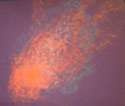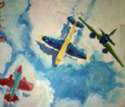
|
Exercise 1
Start with your name. There is a lot of your art in the way you sign your
name. Daniel practiced writing his name until he could choose the one he
liked and keep using that one.
|

|
Exercise 2
Just to get in the flow of drawing choose a drawing that you like and
copy it. For hundreds of years artists have sat in museums and copied great
masters. Picasso said, "Good artists copy and great artists steal."
When you are copying another artist's drawing you actually are putting yourself
in their energy.
|

|
Exercise 3
Just using your imagination try drawing a story. This is a story of someone
in a kayak going through the white water. Put yourself into the story.
If you are holding a paddle how would you look? How would you look sitting
in the boat?
|

|
Exercise 4
This exercise is to draw people by drawing circles first then bringing the
people out of the circles. Try it. Remember that where a body's legs join
is the middle of the body. The head is usually about 1/8 of the body so
if you draw the head first then the body is seven more head lengths. Your
feeling is much more important than your accuracy.
|

|
Exercise 5
Now that we have the feeling for the human body what can we make them do.
Remember gesture drawings in lesson 2? Put some fat on those stick figures.
Start with circles if you wish. Have them dancing, snowboarding, flying,
etc. This exercise can get you going into a full painting. Just draw what
you want to draw!
|

|
Exercise 6
Try drawing some structure. Structure always comes first in any art. Lines
that go horizontal and vertical make up the basis for any art. This exercise
will teach you how to combine these lines with the people circles. Can you
work them into the structure? First draw some horizontal and then some vertical.
Next add some circles and connect them into people.
|

|
Exercise 7
Remembering all the previous sessions work the curved lines into the structure
lines and draw what your imagination tells you to draw. Use your name for
part of the design.
|

|
Exercise 8
Try drawing the structure and then add color....remember, just feel, don't
think!
|

|
Exercise 9
Now think about a place you enjoy. Daniel thought about the beach and how
he felt when he was on the beach. But he remembered the feeling of the structure
of the drawing first and then the colors and feeling of the colors of the
beach.
|

|
Exercise 10
Using watercolors and without seeing sky just think "sky" and
feel what the sky feels like. Now let your watercolor paint "sky."
|

|
Exercise 11
Try making a monoprint of something specific. Daniel loves airplanes. So
he dobbed paint on a plastic surface (could use glass) in the shape of an
airplane. Then he laid paper over this and made airport. It is much more
interesting because he laid in several different colors to print. You cannot
achieve this texture unless you make a print.
|

|
Exercise 12
In 1997 there was a comet visible in the sky and this drawing was the
impression of that comet. The exercise is to remember something you saw
that you felt emotional about and then draw it. Don't worry about accuracy
or perspective or dimension...just feel it and draw.
|

|
Exercise 12
Putting it all together. This was Daniel's first acrylic painting. He remembered
clouds. He always drew airplanes and loved them. He remembered the color
rules - blue rises, red sinks, and yellow moves around. He even entered
from the left and let you exit to the right in the blue sky. Try painting
what you love and loving what you paint.
|

|
This
painting works no matter how you turn it. |

